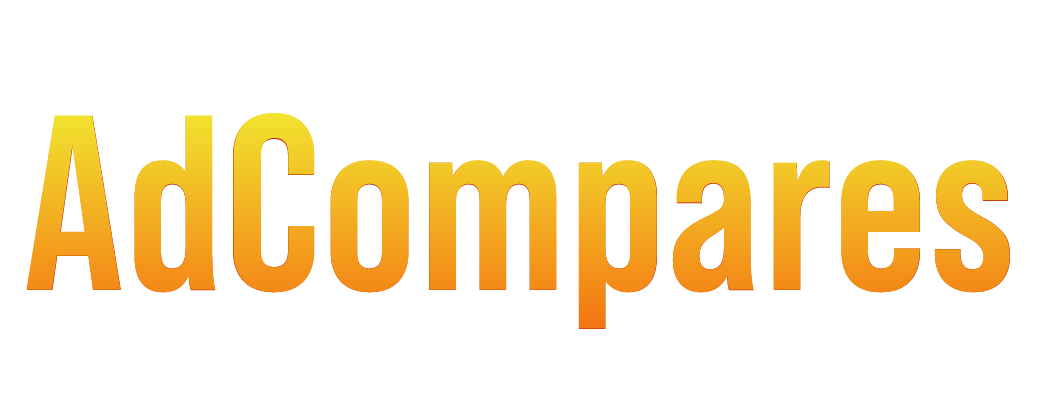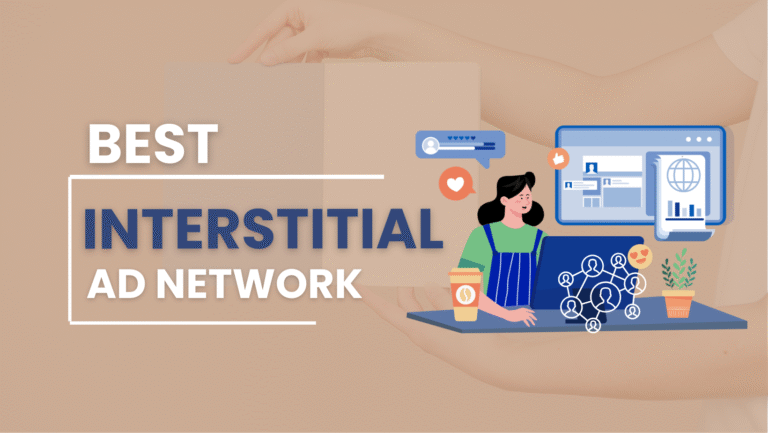In 2026, the bestinterstitial ad networks, mobile apps, and websites will have become essential tools for publishers aiming to maximize revenue and engagement. These full-screen ads appear between page views or app interactions, offering unmatched visibility and higher CPMs than standard formats. Publishers leverage these networks to access global advertisers, precise targeting options, and dynamic creative placements that enhance performance. Selecting the rightinterstitial ad platforms with high CPMs ensures optimal fill rates, seamless integration, and actionable analytics that drive revenue growth and enhance the user experience.
What Is an Interstitial Ad?
An interstitial ad is a high-impact, full-screen advertising format that appears during natural content breaks or transitions, for example, when a user completes a level in a mobile game, navigates to a new page within an app, or moves between different sections of a website. Unlike banner ads that occupy only a portion of the screen, interstitial ads cover the entire interface temporarily, ensuring that the ad captures the user’s complete attention.
Because of their immersive presentation and placement during pauses or loading periods, interstitials often deliver significantly higher viewability and engagement rates compared to smaller ad formats. They are widely adopted in mobile apps, mobile web environments, and even desktop websites, making them a versatile monetization strategy for publishers. Advertisers prefer interstitials because of their ability to convey richer messages, while publishers benefit from the strong revenue potential they bring.
Why Use Interstitial Ads?
Interstitial ads remain a popular choice in digital advertising because they combine visibility, flexibility, and profitability. Here’s why they matter:
- High Visibility: By occupying the full screen, interstitials are almost impossible to ignore, giving advertisers maximum exposure and ensuring users notice the message before continuing their activity.
- Strong Revenue Potential (High CPMs): Advertisers are willing to pay premium rates for full-screen coverage, which often translates to higher CPM (cost per thousand impressions) for publishers compared to standard display ads.
- Creative Flexibility: Interstitials support multiple formats, including static images, interactive rich media, animated graphics, and high-quality video. This flexibility allows brands to deliver more engaging and memorable ad experiences.
- Natural Placement in Transitions: Because they are typically displayed at logical breakpoints like page loads, app launches, or game level completions, they can feel less disruptive to the user journey when implemented thoughtfully.
When used strategically, interstitial ads strike an effective balance between advertiser goals and user experience, making them one of the most powerful tools in mobile and web monetization today.
Top Interstitial Ad Networks for Publishers in 2026
Here are some leading interstitial ad networks in 2026, with details about strengths and use cases.
- AdMob
- Applovin
- Millennial Media
- ExoClick
- AdMaven
- InMobi
- Facebook Audience Network
- StartApp
1. AdMob
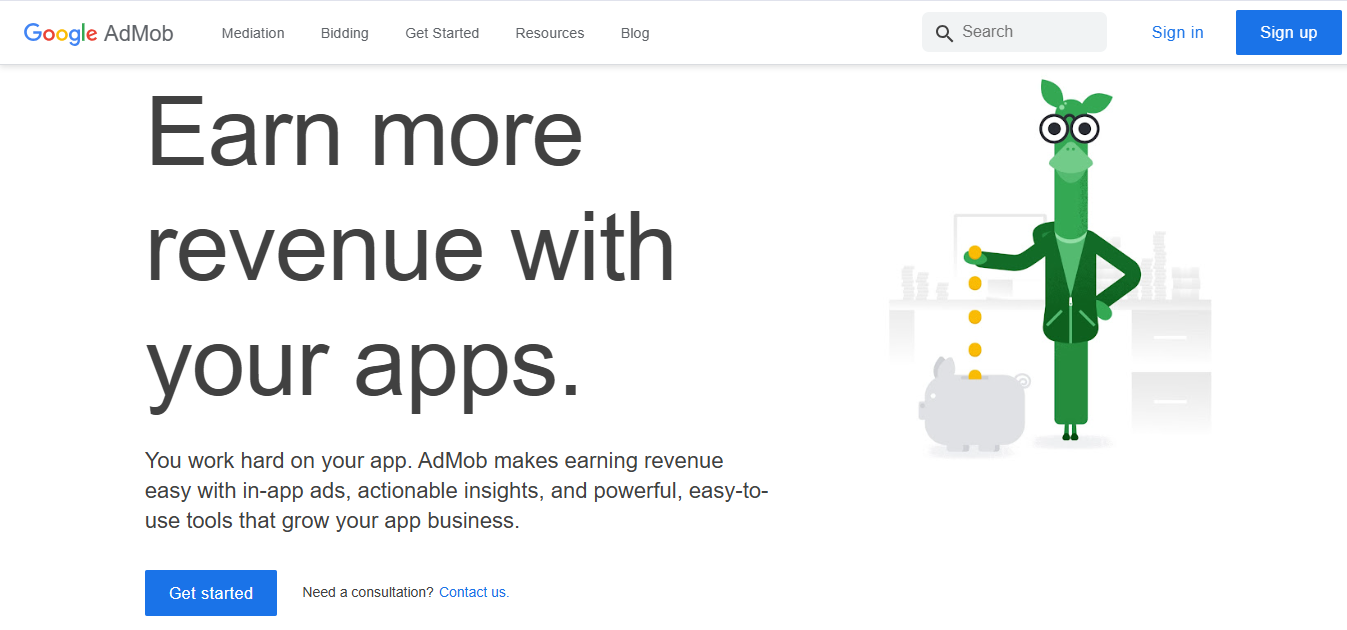
AdMob, a Google-owned platform, is widely used by mobile app developers for both Android and iOS apps. It connects app publishers with a global pool of advertisers through Google’s extensive ad network. The platform provides detailed analytics for monitoring revenue, user engagement, and ad performance, making it a preferred choice for reliable app monetization across different regions.
Features:
- Real-time analytics and reporting for impressions, clicks, and revenue.
- Automated mediation for multiple ad networks to maximize fill rates.
- Support for rewarded ads to increase user engagement without disrupting UX.
Integration:
- Seamless integration with Android and iOS apps using the AdMob SDK.
- Compatible with Google Analytics and Firebase for deep insights.
- Supports mediation with other ad networks to maximize revenue potential.
Best For:
- Mobile app developers are seeking stable monetization options.
- Publishers targeting global audiences through Google’s ad ecosystem.
- Small to large app publishers need detailed analytics and performance tracking.
Pros:
- High fill rates due to Google’s extensive advertiser network.
- Advanced targeting and audience segmentation.
- Supports multiple ad formats, including video and interstitial.
Cons:
- CPC and CPM rates may be lower compared to specialized ad networks.
- Approval and compliance rules can be strict for new apps.
- Limited flexibility in creative types compared to niche networks.
2. AppLovin
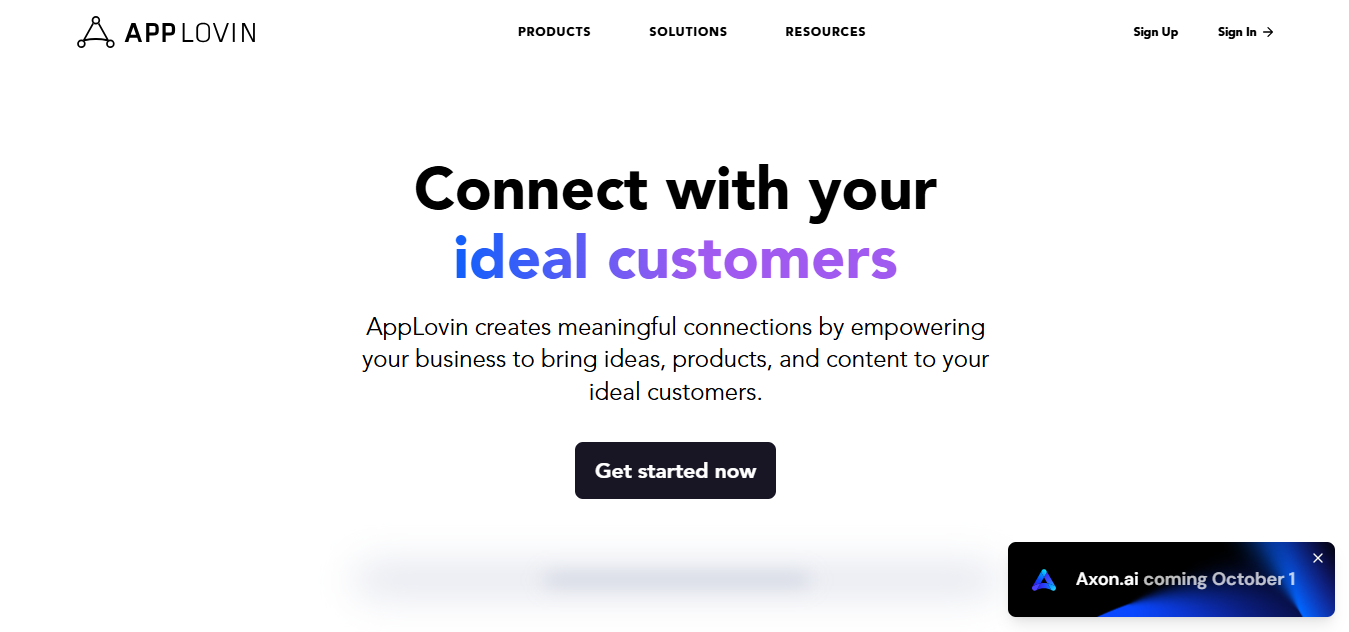
AppLovin is a self-service mobile ad network focusing on app monetization and user acquisition. It supports a broad audience across multiple countries and optimizes campaigns in real time for maximum revenue. AppLovin enables app publishers to scale efficiently while offering tools to enhance engagement and ad performance.
Features:
- Real-time bidding for high CPM inventory.
- Dynamic creative optimization for better engagement.
- Detailed analytics on installs, conversions, and in-app behavior.
Integration:
- Supports Android and iOS SDK integration for apps.
- Compatible with third-party analytics and attribution tools like AppsFlyer.
- Easy mediation setup to combine multiple ad networks in one app.
Best For:
- Mobile game publishers are seeking high-quality interstitial and video ads.
- Apps focusing on user acquisition campaigns.
- Developers targeting multiple regions and platforms simultaneously.
Pros:
- Strong focus on maximizing eCPM with optimization algorithms.
- Supports playable interstitials for interactive user experiences.
- Offers precise targeting for user acquisition campaigns.
Cons:
- May require technical setup for SDK integration.
- CPM can vary significantly across regions.
- Limited support for web-based apps or desktop traffic.
3. Millennial Media
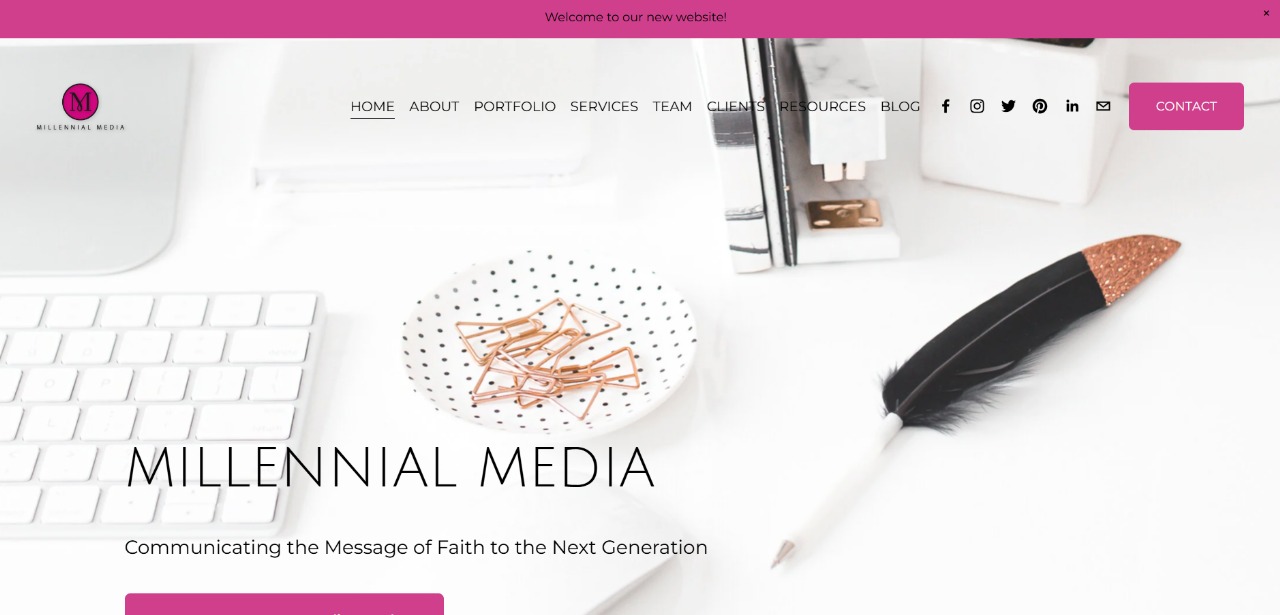
Millennial Media is a mobile advertising network focused on delivering high-impact interstitial ads across smartphones and tablets. The platform specializes in brand-safe inventory and provides global reach for both iOS and Android publishers. It connects app developers with premium advertisers while supporting scalable monetization and strong audience engagement.
Key Features
- High-quality interstitial and rich media ad formats optimized for mobile devices
- Advanced targeting by location, device type, and user behavior
- Real-time analytics to monitor impressions, clicks, and revenue performance
Integration
- SDK integration available for iOS and Android apps
- Compatible with major mediation platforms for revenue optimization
- Supports integration with analytics and attribution tools for detailed tracking
Best For
- Mobile app developers seeking brand-safe, high-quality interstitial ads
- Publishers targeting diverse global audiences across multiple verticals
- Marketers need strong mobile reach and data-driven targeting
Pros
- Broad advertiser demand ensures strong fill rates and competitive eCPM
- Reliable analytics and reporting for performance tracking
- Flexible targeting options for precise audience engagement
Cons
- Requires SDK integration and technical setup
- Limited support for desktop or web traffic
- CPM rates can vary based on region and app category
4. ExoClick
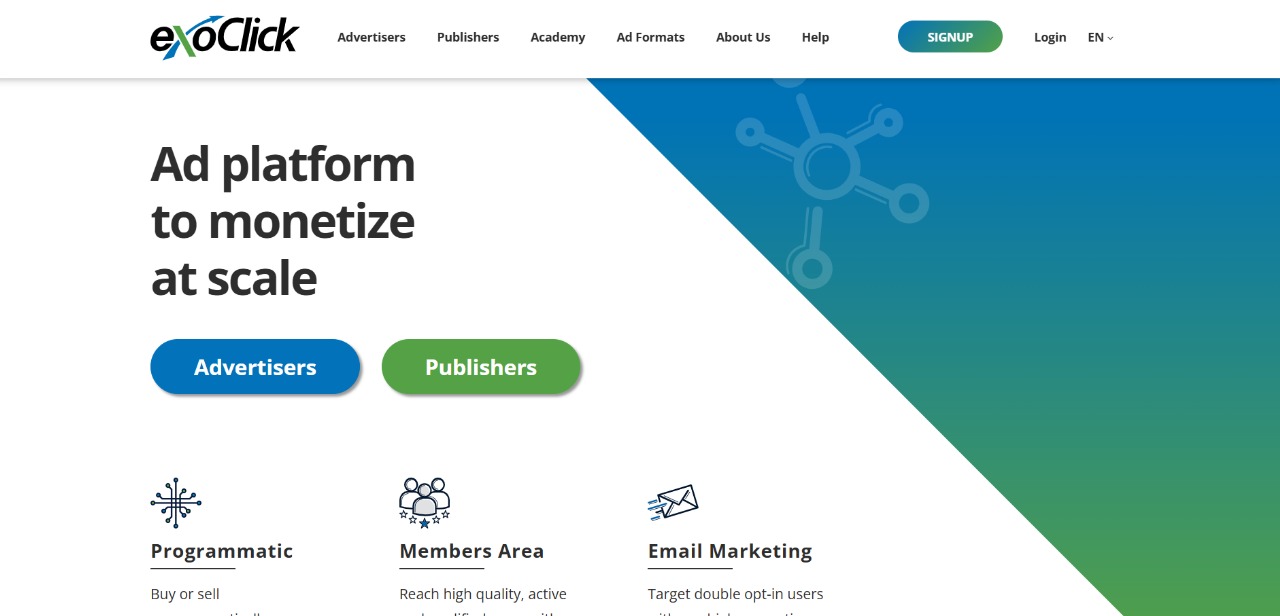
ExoClick is a popular ad network among web publishers, especially for high-traffic and niche websites. It provides interstitial ads in addition to popunders, banners, and native ad formats. ExoClick connects publishers with advertisers across multiple verticals, offering flexible placements and consistent revenue opportunities.
Features:
- Multiple ad formats, including interstitial, native, and popunder ads.
- Advanced targeting by geo, device, OS, and traffic type.
- Real-time reporting and analytics for campaign optimization.
Integration:
- Easy integration via JavaScript code snippets on web pages.
- Supports WordPress and custom CMS platforms.
- Compatible with third-party analytics and tracking tools.
Best For:
- Web publishers monetizing adult or niche traffic.
- Small and medium websites require self-service ad platforms.
- Publishers need flexible ad format options.
Pros:
- High fill rates for global traffic.
- Flexible pricing models, including CPM and CPC.
- Supports multiple ad formats for diversification.
Cons:
- Best performance may be limited to adult or high-intent traffic.
- Some ad formats may negatively impact UX if not optimized.
- Support can be slower compared to premium networks.
5. AdMaven
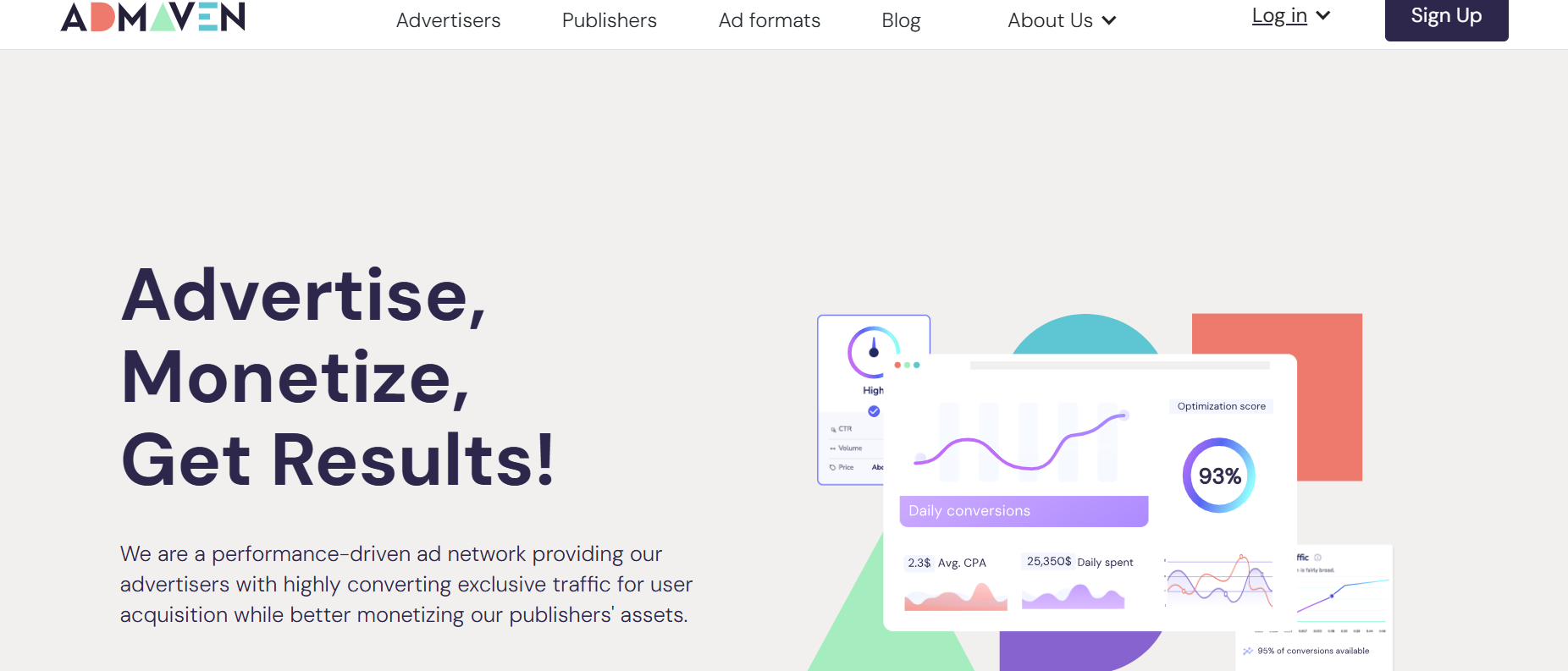
AdMaven offers interstitial ad solutions for both web and mobile publishers. Its self-service platform allows fast setup and global ad coverage. AdMaven ensures steady monetization for small to medium publishers and supports a variety of traffic sources with reliable ad demand.
Features:
- Full-screen interstitials for mobile and desktop.
- Push and pop-up ad integration for multi-channel monetization.
- Real-time analytics and optimization tools.
Integration:
- Easy JavaScript integration on web pages.
- WordPress plugin support for faster setup.
- Compatible with analytics platforms for performance tracking.
Best For:
- Small web publishers seeking flexible monetization options.
- Bloggers and niche websites targeting global audiences.
- Publishers looking for self-service networks with minimal setup.
Pros:
- Multiple ad formats increase monetization opportunities.
- Low minimum payout for small publishers.
- The global advertiser network provides consistent demand.
Cons:
- Some ad formats may be intrusive to users.
- CPM can vary significantly by region and traffic type.
- Limited support for mobile app integration.
6. InMobi
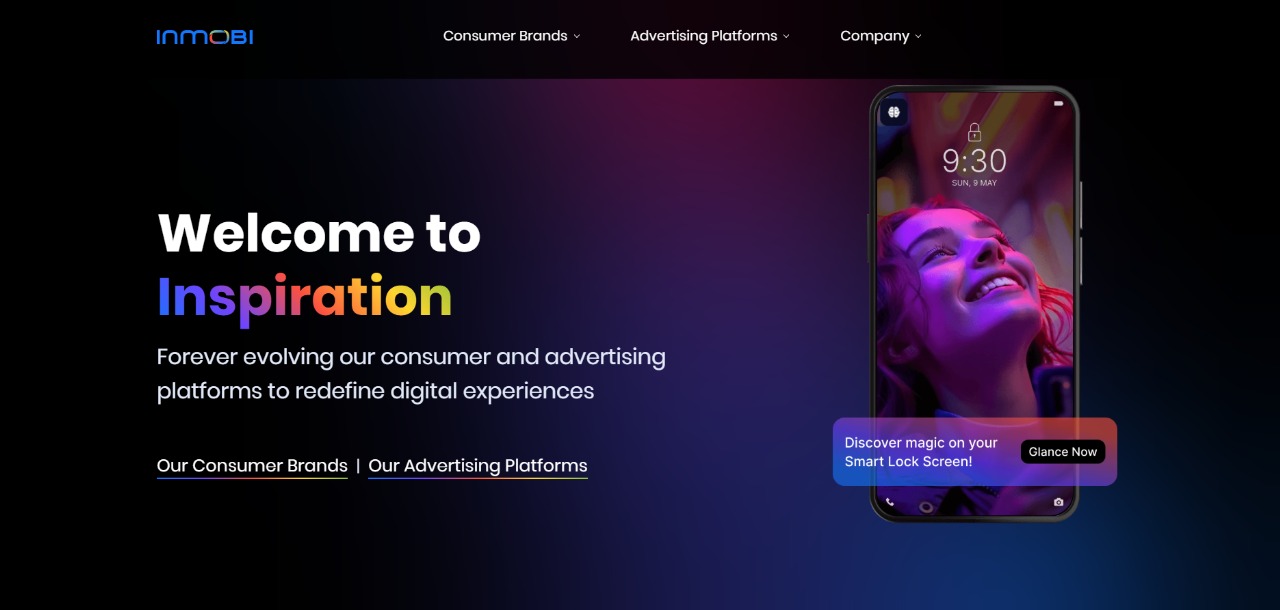
InMobi is a mobile-focused ad network that supports interstitial ad placements within apps. It reaches global audiences and connects publishers with premium advertisers in multiple industries. InMobi provides analytics and optimization tools that help app developers scale revenue while maintaining a quality user experience.
Features:
- Contextual and behavioral targeting for better engagement.
- Full-screen interstitials and native ad support.
- Real-time reporting and analytics for app publishers.
Integration:
- SDK for Android and iOS integration.
- Works with analytics platforms and attribution tools.
- Supports mediation to optimize revenue across networks.
Best For:
- Global mobile app publishers seeking high-quality interstitials.
- Brands targeting specific devices, OS, and user behaviors.
- Developers are focusing on high user engagement through ads.
Pros:
- Advanced targeting increases relevance and eCPM.
- Multi-format support for mobile apps.
- Strong global advertiser base.
Cons:
- Requires SDK integration.
- Performance may vary by region and vertical.
- Limited web traffic support.
7. Facebook Audience Network
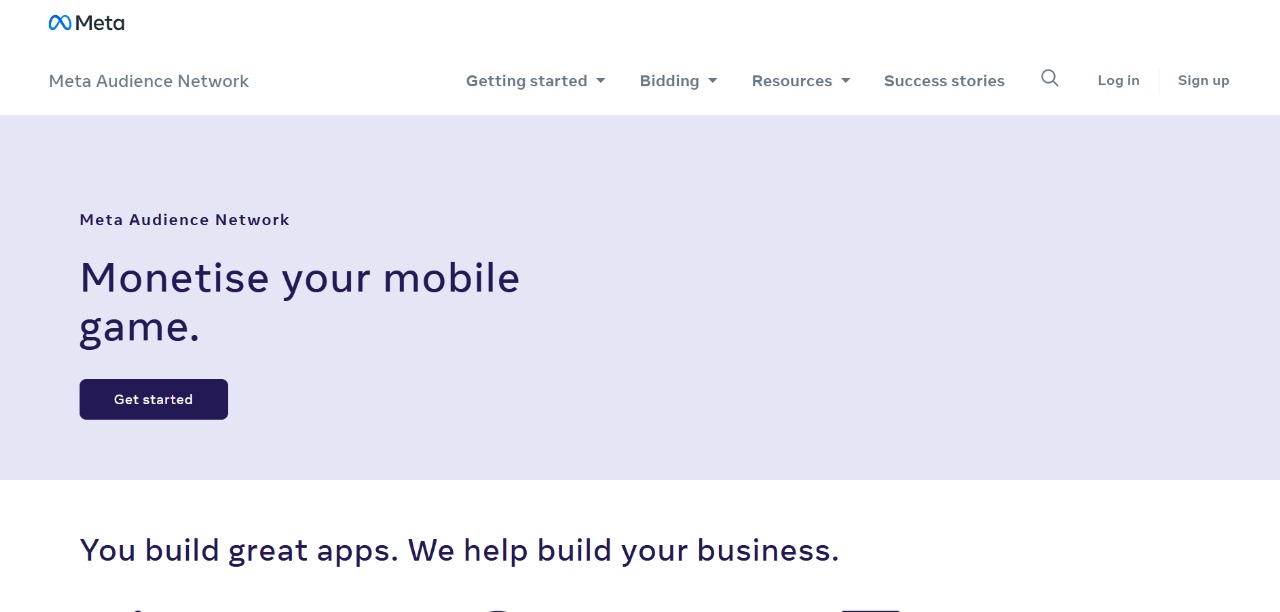
Facebook Audience Network extends Facebook Ads into third-party mobile apps. It allows publishers to monetize app traffic by leveraging Facebook’s targeting and demand. FAN provides interstitial ad placements along with analytics, reliable advertiser demand, and tools to track performance effectively.
Features:
- Supports interstitial and rewarded ads in apps.
- Detailed targeting using Facebook’s audience data.
- Analytics for conversions, impressions, and engagement.
Integration:
- SDK integration with iOS and Android apps.
- Compatible with third-party measurement tools.
- Connects with Facebook Ads Manager for centralized campaign management.
Best For:
- Mobile app developers seeking access to Facebook’s audience.
- Publishers targeting social media-driven app users.
- Brands looking for precise demographic and interest targeting.
Pros:
- Leverages Facebook’s large user base for targeting.
- Detailed analytics and reporting.
- Supports rewarded ads to improve engagement.
Cons:
- Limited ad formats compared to full mobile ad networks.
- Requires integration with the Facebook SDK.
- Performance depends on user activity and app vertical.
8. StartApp
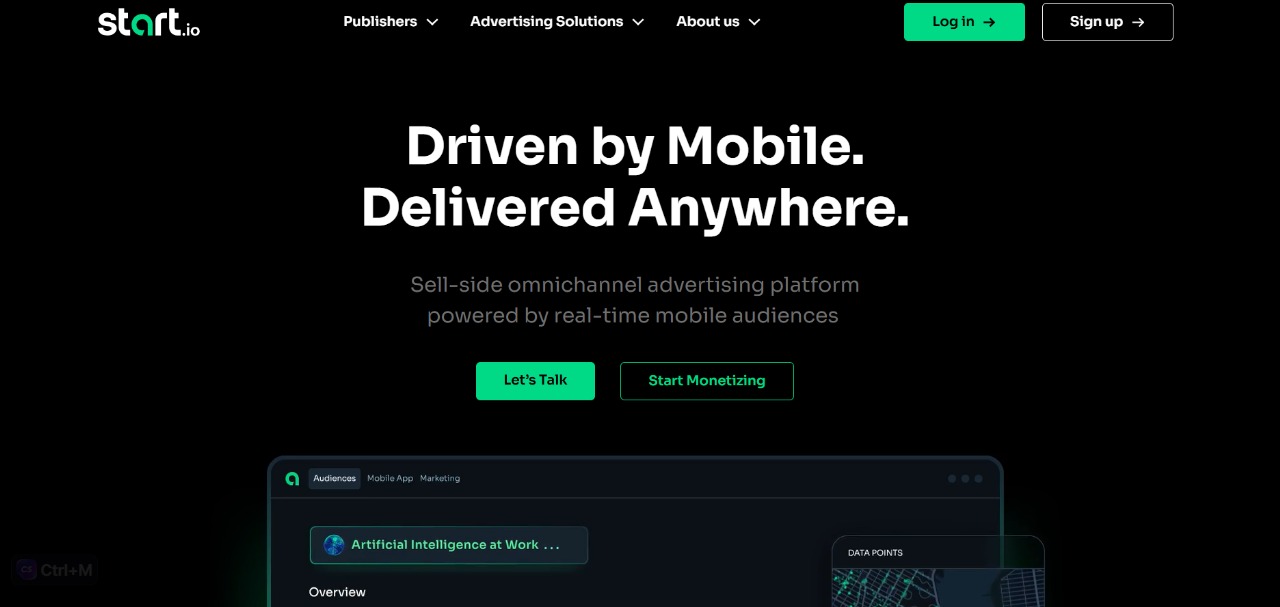
StartApp is a mobile-focused ad network that allows app publishers to monetize through interstitials, banners, and native ads. It serves a global audience and connects developers with advertisers across multiple verticals. The network provides real-time analytics and reporting tools to help publishers track performance and optimize revenue while maintaining a smooth user experience.
Features:
- Interstitial Ads: Full-screen ads displayed at natural transition points in apps.
- Native Ads: Ads integrated seamlessly within app content for less intrusive monetization.
- Real-Time Analytics: Track impressions, clicks, revenue, and user engagement metrics.
Integration:
- SDK Integration: Easy integration with Android and iOS apps.
- Third-Party Platforms: Compatible with mediation tools like MoPub or AdMob.
- Campaign Management: Manage ad placements and formats directly from the StartApp dashboard.
Best For:
- Mobile app developers are looking to monetize free apps efficiently.
- Startups and indie developers seeking global ad inventory access.
- Apps targeting casual gamers and utility app users with high engagement potential.
Pros:
- High fill rates for interstitials and native ads.
- Flexible ad formats for various app categories.
- Access to a global network of advertisers.
Cons:
- Revenue can fluctuate depending on app category and user location.
- Some users report intrusive ad placements if not optimized carefully.
- Limited support for advanced targeting compared to larger networks, such as AdMob.
Key Considerations Before Choosing an Interstitial Ad Network
When evaluating interstitial networks, be sure to check the following:
- Fill Rate & Coverage: How often the network can fill your ad slots; high fill rates across geographies matter.
- Pricing Models: CPM, CPC, or hybrid models; fixed rates vs dynamic bidding.
- Payment Terms & Thresholds: Minimum payout, payment frequency, and supported payment methods.
- Ad Quality & Safety: Avoid networks with high ad fraud or low-quality creatives.
- SDK or Integration Overhead: Whether the network uses heavy SDKs (in apps) or lightweight code (for web).
- Targeting & Optimization Tools: Ability to target by geo, device, OS, behavior, and real-time algorithmic optimization.
- Support & Reporting: Transparency in reports, fraud protection, and support responsiveness.
Conclusion
In 2026, the best interstitial ad network for publishers in 2026is no longer just about selecting the platform with the highest payouts; it’s about striking the right balance between maximizing revenue potential and ensuring a smooth, non-intrusive user experience. With the digital advertising landscape becoming more competitive, publishers need solutions that combine strong monetization opportunities with audience retention strategies.
Leading networks such as AdMob, AppLovin, AdColony, ExoClick, AdMaven, InMobi, Facebook Audience Network, StartApp, and Millennial Media continue to dominate the market by offering global advertiser access, advanced targeting options, and scalable revenue models. These platforms are known for delivering high-quality interstitial ads that not only drive conversions for advertisers but also maintain user engagement when implemented thoughtfully.
Frequently Asked Questions (FAQS)
What is an interstitial ad network?
An interstitial ad network connects publishers with advertisers to deliver full-screen ads between content pages or app interactions, ensuring higher visibility and CPM rates.
Are interstitial ads good for mobile apps?
Yes. Interstitial ads fit mobile screens naturally and engage users between app actions, which supports strong click-through rates and monetization.
Which interstitial network pays the highest CPM?
CPM varies by niche and region, but Google AdMob, AppLovin, and AdColony consistently report competitive eCPM for both Android and iOS apps.
Do interstitial ads affect user experience?
Poorly timed ads can disrupt sessions. Correct frequency capping and strategic placement maintain engagement while generating revenue.
Can interstitial ads run alongside other formats?
Yes. Publishers often combine interstitials with banners, rewarded video, or native ads to diversify revenue without sacrificing usability.
How do publishers track performance?
Most networks offer dashboards with metrics like impressions, eCPM, CTR, and fill rate. Integration with tools such as Google Analytics provides deeper insight.
Are interstitial ad networks suitable for small publishers?
Yes. Many networks like AdMaven and StartApp accept low-traffic sites and mobile apps, making them accessible to new publishers seeking scalable income.
